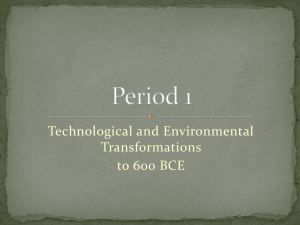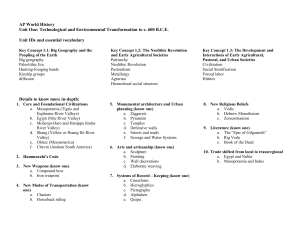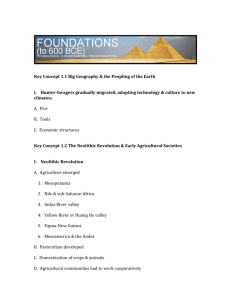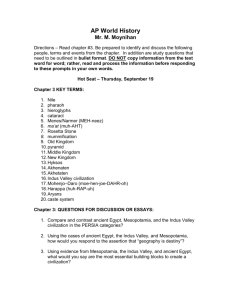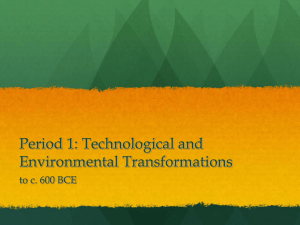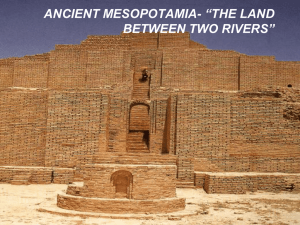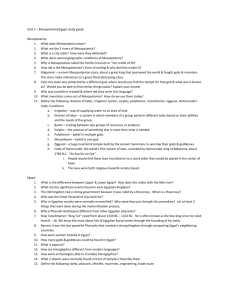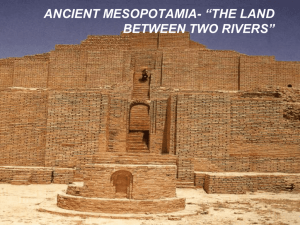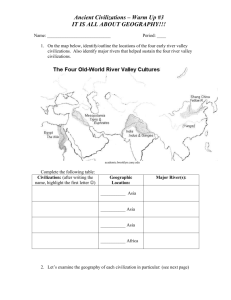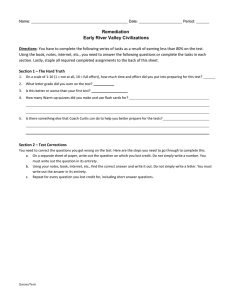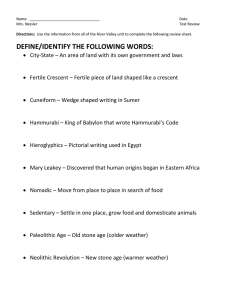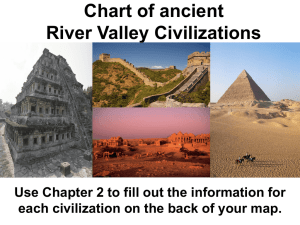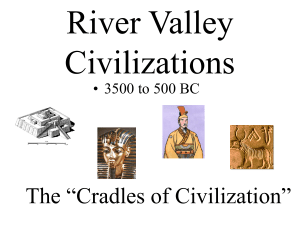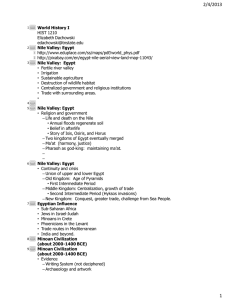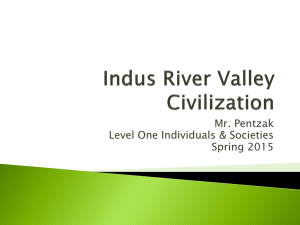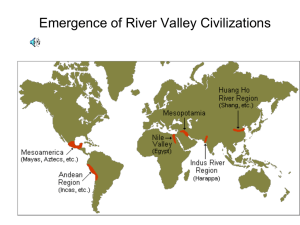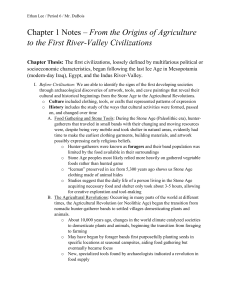Neolithic Revolution and River Valleys
advertisement
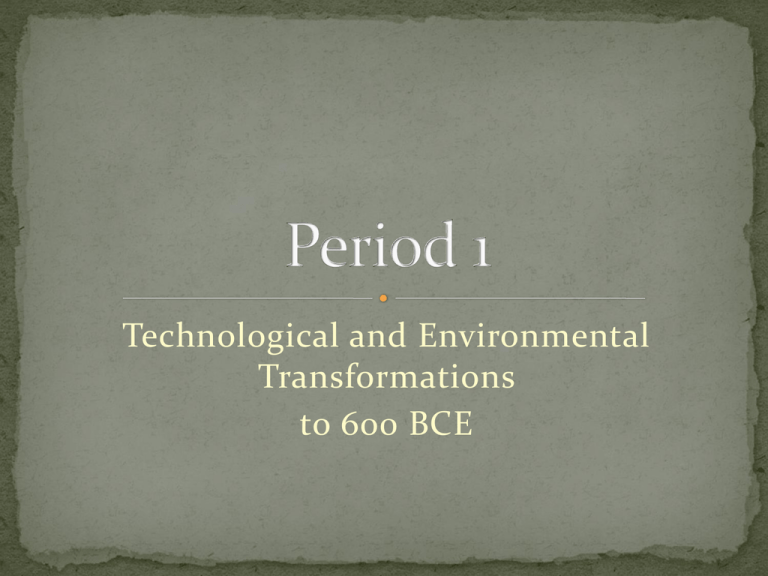
Technological and Environmental Transformations to 600 BCE Big Geography and the Peopling of the Earth Early human development occurred during the Paleolithic Period Origins in Africa Hominids Anatomically modern humans (homo sapiens sapiens) develop about 150,000 years ago Begin migrations Lucy http://www.answersingenesis.org/articles/am/v2/n2/they-lovelucy http://evolution.berkeley.edu/evosite/evo101/IIE2cHuma nevop2.sht ml Settlement of Australia: Approximately 60,000 BCE Settlement of Eurasia: Approximately 50,000 BCE Settlement of Americas: Approximately 14,000 BCE Questions to Consider…. 1. What was life like in the Paleolithic Period? 1. 2. 3. 4. 5. 6. 7. 8. 9. 10. 11. Food? Shelter? Social Status? Gender Roles? Family Size? Division of Labor? Government? Religion? Health? Tool making? Etc…. Hunting-foraging Nomadic Small groups based on bonds of kinship Relatively Egalitarian Adaptation to local environment Development of stone tools Use of fire for cooking, warmth, and deterring predators No written language Evidence of culture seen in cave paintings, artifacts, and human remains Evidence of primitive, simple religion Lack of developed material culture Although groups were adapted to their specific environment, hunter-foragers did interact with each other and engage in exchange of ideas and goods The Neolithic Revolution and Early Agricultural Societies Neolithic: New Stone Age Began approx. 10,000 years ago Use of stone tools for agricultural production Most likely the result of climate change…WHY? Domestication of plant and animal species See map on page 9 in textbook First began in the Eastern Mediterranean http://huberb.people.cofc.edu/ANTH%20101%20Huber's%20Introduction%20to%20Anthropology.html Gradual process and dependent upon the geography Not all societies develop agriculture See map on page 9 of textbook. Agricultural centers emerged in: Mesopotamia, the Nile River Valley, Sub-Saharan Africa, the Indus River Valley, the Yellow River, Papua New Guinea, Mesoamerica, and the Andes Emerged in grasslands (steppes) Central Eurasia and parts of Africa Animal husbandry Mobile lifestyle (nomadic) Wealth measured in livestock Greater degree of complexity and cooperation More reliable food sources Population densities increase Permanent settlements Religion becomes more complex Some matrilineal, others patrilineal Trade developed between and among early agricultural settlements http://www.americanneopaganism.com/ancientp agantimeline.htm http://www.newworldencyclopedia.org/en try/Catal_Huyuk http://howardbloom.net/reinventing_capitalism/ http://www.newworldencyclopedia.org/entry/Image:CatalHoyukSouthArea.JPG Dramatic impact on the environment Erosion Clearing of forests for farmland Desertification Overgrazing of pastureland Increase in human population Increase in disease…WHY? Craft specialization…WHY? Social Stratification…WHY? Patriarchy…WHY? Technological innovations were developed to improve agricultural production, trade, and transportation Key examples: Pottery Plows Woven textiles Metallurgy Wheels and wheeled vehicles http://www.historiasiglo20.org/prehistory/po ttery.htm The Development and Interactions of Early Agricultural, Pastoral, and Urban Societies Core and foundational civilizations emerged in the following: Mesopotamia Egypt Mohenjo-Daro and Harappa Shang China Olmec Chavin Map quiz: Students will take a quiz to identify the core and foundational civilizations. What are the characteristics of a civilization???? Characteristics: http://www.unionparishschools.org/rivervalleyciv/interest.htm Mesopotamia http://www.utexas.edu/courses/classicalarch/images2/mapane.jpg Egypt http://www.iziko.org.za/sh/resources/egypt/images/map_e1 _l.gif Indus River Valley Civilization http://www.rivervalleycivilizations.com/indus.php The Yellow River Valley Civilization Shang Dynasty http://www.chinahighlights.com/image/map/ancient/shang-dynasty-map1.gif http://en.wikipedia.org/wiki/File:Chavin-small.png http://theresaclarkintdis4.blogspot.com/2009/09/week6.html State: a sovereign political entity which contains a stable population, defined territory, and established government Control over larger territory, population, and resources Divine Right Military Competition for land and resources Geography Bronze Iron Horses Chariots Composite bows http://www.encyclopedia.com/topic/Hyksos.aspx Architecture and Urban Planning Arts and Artisanship Systems of Record Keeping Law Codes Religion Polytheism: Belief in many gods Most common Vedic Religion becomes basis of Hinduism Monotheism: Belief in one god Hebrews Zoroastrianism (Persian Empire) Trade Local, regional, and transregional trade Exchange of goods, cultural ideas, and technology Examples: Egypt and Nubia Mesopotamia and Indus River Valley
